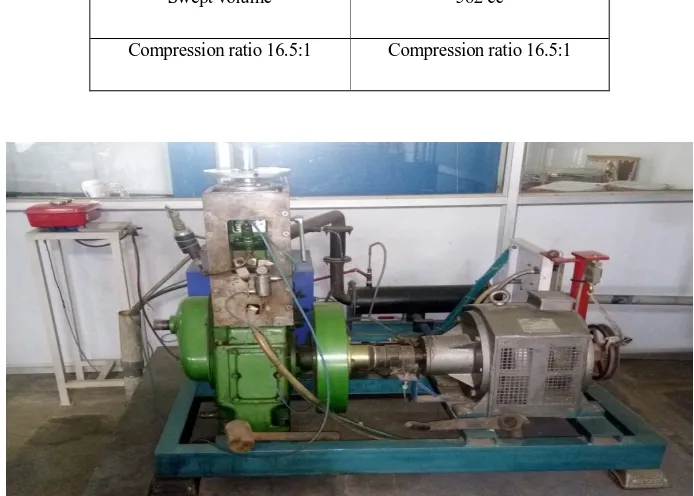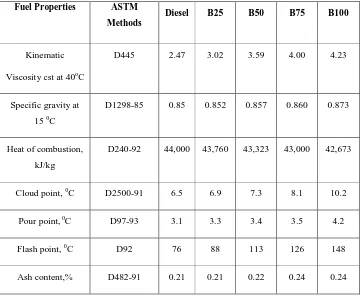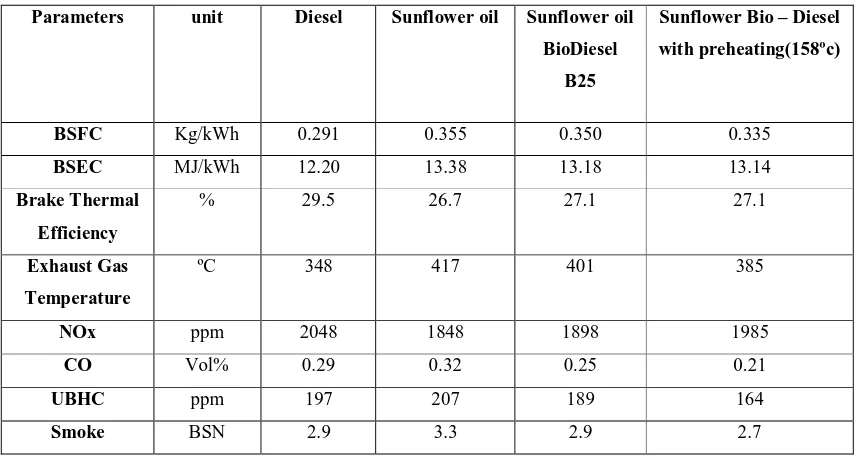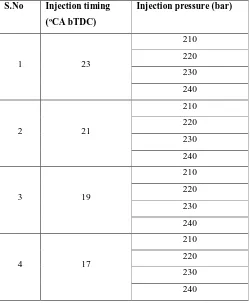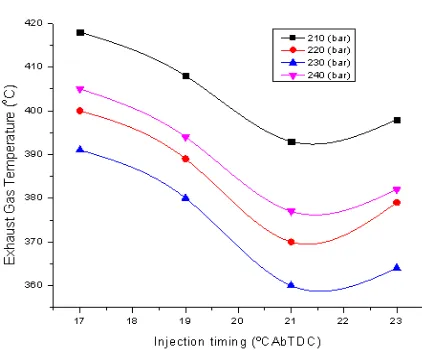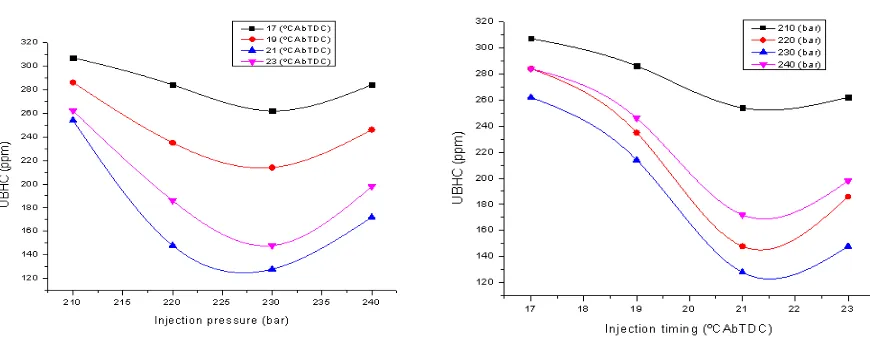Research article
Available online www.ijsrr.org
ISSN: 2279–0543
International Journal of Scientific Research and Reviews
Effect of Injection Timing on Performance and Combustion
Characteristics of a Diesel Engine Fuelled with Diesel and Methyl Ester
of Sunflower oil
Sureddy Kirankumar
*and Govind N.
Research Scholar, Department of Mechanical Engineering, University College of Engineering and Technology, Acharya Nagarjuna University, Guntur, A.P, India.
E-mail: kirankumar.sureddy@gmail.com,Phone No:9505679999
Associate Professor, Department of Mechanical Engineering, Rvr&Jc College of Engineering and Technology, Guntur, A.P, India,E-mail: ng @ rvrjc.ac.in,Phone No: 9849467021.
ABSTRACT
A great attention has been received by diesel engines due to their high power performance,
thermal efficiency and low emissions in comparison with gasoline engines. Transportation systems
sector consumes a large portion of non-renewable petroleum fuels. For a renewable fuel resource it is
urgent look that will replace traditional fuels. Production of biodiesel from vegetable oils is one of
promising resources. In this present work initially experiments are conducted using diesel and
sunflower oil methyl ester (SME) with different injection timings at the rated speed of 1500 rev/min
under variable load conditions. Load speed, air flow rate, fuel flow rate, exhaust gas temperature, and
exhaust emissions of carbondioxide, nitric oxide and smoke are observed, cylinder pressure position
signals are recorded for processing to obtain combustion parameters.
KEYWORDS
: Diesel, Methyl ester, injection timing, transportation, emissions, performance.*Corresponding author
Kirankumar sureddy
Department of Mechanical Engineering, University College of Engineering
and Technology, Acharya Nagarjuna University, Guntur, A.P, India.
INTRODUCTION
The physical properties of the biodiesel fuel such as viscosity, flash point effect the different
process occurring within the diesel engine cylinder; including fuel evaporation, fuel mixing with air,
fuel atomization and fuel burning and engine performance. In metering the desired amount of fuel at
correct time depending on engine operating conditions plays an important role is injection timing (IT).
The increase of injection timing is recorded as one of the basic parameters that tend to reduce particulate
matter emissions and fuel consumption in addition to other influences; including the increase of fuel
portion burned by premixed combustion, the increase of mixture homogeneity, the increase of local A/F
ratio, the decrease of combustion duration, the increase of the in-cylinder peak pressure, and the
increase of NOx emissions. Kumar et al.1 studied the effect of compression ratio, fuel atomization,
Injection Timing, fuel quality, combustion rate, A/F ratio, intake temperature and pressure on engine
performance parameters. Authors founded that, the increase in air motion into diesel engine improves
the fuel atomization, the heat release rate and reduces the levels of exhausted emissions. Sayin et al.2
studied the effect of fuel atomization and fuel distribution through combustion chamber using a single
cylinder diesel engine operated with canola oil methyl esters (COME) and its blends with diesel fuel.
The experimental results showed that, fuel exhibits different combustion and performance
characteristics for different IT and engine loads. From their study, Sayin et al.2 Kannan and
Udayakumar3 studied the effect of IT on performance and emissions from diesel engine. Authors
concluded that, good performance and low emissions occur at high IP of 200 bar. Canakci et al. 4
observed the decrease of engine mechanical performance parameters and the increase of most engine
emissions (smoke opacity, UHC and CO) except NOx and CO2 when the injection pressure becomes
lower than the engine original injection pressure. Nagaraju et al. 5 carried out an experimental study to
determine the effect of using B20 (fuel blend containing 20% soybean methyl ester biodiesel and 80%
neat diesel fuel) on the combustion process, performance and exhaust emissions of diesel engine. Their
results indicated that, the emissions of NOX, CO, UHC and soot for B20 are lower than those for diesel
fuel, while BSFC and Texh are higher for B20 than for diesel fuel. Krahl et al.6 studied the effect of using
biodiesel fuels on diesel engine performance and concluded that, the high BSFC and low brake power
(BP) obtained with biodiesel are related to the biodiesel low heating value. Purushothaman et al. 7
investigated the effect of IP on the combustion process and the exhaust emissions of diesel engine
fueled with orange skin powder diesel solution. The results indicated that orange skin powder-diesel
solution gives superior combustion and emissions characteristics as compared to diesel fuel at IP of 235
bars. Monyem et al. 8 reported that the advance of injection timing of about 2.3 LC.A. is necessary for
pump setting. The injection timing advance is attributed to the physical property differences between
biodiesel and diesel fuel; higher viscosity, higher molecular weight and fatty acid contents and so higher
bulk modulus for biodiesel than that of diesel fuel. This optimization can be achieved at the proper
match between the IP and the combustion cylinder geometry. The aim of the present work is to
investigate the effect of blended fuels on the engine Performance and Combustion Characteristics using
diesel and methyl ester of sunflower oil with different injection timings.
FUEL INJECTION SYSTEM
The purpose of the fuel injection system is to deliver fuel into the engine cylinders, while
precisely controlling the injection timing, fuel atomization, and other parameters. The main types of
injection systems include pump-line-nozzle, unit injector, and common rail. Modern injection
systems reach very high injection pressures, and utilize sophisticated electronic control methods. The
performance of diesel engines is heavily influenced by their injection system design. In fact, the most
notable advances achieved in diesel engines resulted directly from superior fuel injection system
designs. While the main purpose of the system is to deliver fuel to the cylinders of a diesel engine, it
is how that fuel is delivered that makes the difference in engine performance, emissions, and noise
characteristics. The primary purposes of the diesel fuel injection system are graphically represented
in plate 1.
Plate 1: Main Functions of Diesel Fuel Injection System
EXPERIMENTAL SET UP AND PROCEDURE
Experimental Set Up
: The engine shown in plate 2 is a 4 stroke, PC Based vertical singlecylinder, water cooled, diesel engine coupled to electrical dynamometer, specifications were written
in table 1. Cooling water lines are fitted with temperature measuring thermocouples provided for
engine cooling. A measuring system for fuel consumption consisting of a fuel tank, burette, and a 3-
way cock mounted on stand and stop watch are provided. Air intake is measured using an air tank
fitted with an orifice meter connected to a water U-tube differential manometer. A digital
temperature indicator and a digital rpm indicator are provided for temperature and speed
experiments were conducted at the engine speed of 1500 rpm. Initially experiments are conducted
using diesel and methyl ester of sunflower oil with different injection timings at the rated speed of
1500 rev/min under variable load conditions. Load speed, air flow rate, fuel flow rate, exhaust gas
temperature, and exhaust emissions of carbon dioxide, nitric oxide and smoke are observed, cylinder
pressure position signals are recorded for processing to obtain combustion parameters. In the second
phase, methyl ester of sunflower oil is blended with diesel in different proportions. Performance,
emissions and combustion parameters are analyzed and compared with neat diesel operation. All the
test values were noted down thrice and average value was taken to avoid the errors in readings. Some
of the properties of sunflower oil, sunflower methyl esters and its blends. It is very important to
know the properties of fuel with blends. Different blends were tested and the properties are noted.
Table 1 Specifications of the Test Engine
Particulars Specifications
Make Kirloskar
Rated Power 3.7 kw(5hp)
Bore 80 mm
Stroke Length 110 mm
Swept volume 562 cc
Compression ratio 16.5:1 Compression ratio 16.5:1
4. RESULTS AND DISCUSSION
The effect of bio diesel blend with diesel on the properties of the fuel has been discussed.
Effect of variation of injection timing with diesel and bio diesel are also studied. It is also discussed
in detail about the effect of biodiesel blend with diesel on the performance, emission and combustion
parameters of the diesel engine. Optimum fraction of additive blended with diesel is also identified.
4.1 Fuel Properties of Diesel, Methyl Ester of Sunflower Oil and Biodiesel Blends
The properties are given in table 4.1. In sunflower biodiesel blended fuels, increase in amount
of diesel fuel has shown no effect on specific gravity of fuel. The kinematic viscosity of sunflower
biodiesel blended fuels increased with increase in amount of biodiesel level. The viscosity of B25
biodiesel blended fuel is 3.02 cst which almost closer to desirable viscosity of diesel fuel (2.47 cst).
The calorific value of blended fuel improved by addition of diesel fuel in the biodiesel blends. The
heating value increased with decease in biodiesel amount. The blended fuels had effect in reducing
the flash point of the sunflower oil blended fuels, which indicated the improvement in the volatile
nature of the fuels. The flash point of blended fuels increased with increase in amount of biodiesel in
the fuels. Similar trend observed for ash content of blended fuels. The fuel properties of sunflower
biodiesel blended fuels met the diesel fuel and biodiesel standards.
Table 4.1 properties of diesel, methyl ester of sunflower oil and biodiesel blends
Fuel Properties ASTM
Methods
Diesel B25 B50 B75 B100
Kinematic
Viscosity cst at 40oC
D445 2.47 3.02 3.59 4.00 4.23
Specific gravity at
15 0C
D1298-85 0.85 0.852 0.857 0.860 0.873
Heat of combustion,
kJ/kg
D240-92 44,000 43,760 43,323 43,000 42,673
Cloud point, 0C D2500-91 6.5 6.9 7.3 8.1 10.2
Pour point, 0C D97-93 3.1 3.3 3.4 3.5 4.2
Flash point, 0C D92 76 88 113 126 148
4.2 Optimization of Injection Timing with Diesel and Methyl Ester of Sunflower
Oil
In the first phase of this work, performance and emission studies carried out on the normal
diesel engine using diesel and methyl ester of sunflower oil as fuels. At the rated speed of 1500
rev/min, variable load tests conducted at different blends B25, B50, B75, B100. Of all the blends
B25 shows best results. B25 blend is preheated to 158°c conducted comparisons test between diesel,
Biodiesel-B25, Preheated Biodiesel-B25, at base operating conditions shown in the table 4.2
Table 4.2 Comparison of performance and emission parameters of different test fuels (full load) at standard
condition
Parameters unit Diesel Sunflower oil Sunflower oil
BioDiesel
B25
Sunflower Bio – Diesel
with preheating(158ºc)
BSFC Kg/kWh 0.291 0.355 0.350 0.335
BSEC MJ/kWh 12.20 13.38 13.18 13.14
Brake Thermal
Efficiency
% 29.5 26.7 27.1 27.1
Exhaust Gas
Temperature
ºC 348 417 401 385
NOx ppm 2048 1848 1898 1985
CO Vol% 0.29 0.32 0.25 0.21
UBHC ppm 197 207 189 164
Smoke BSN 2.9 3.3 2.9 2.7
From the above discussion, it is observed that the emission values of Sunflower Bio Diesel
are better compared to that of Diesel. Preheated Sunflower Bio Diesel is giving lower emissions
compared to Sunflower Bio Diesel except NOx. Similarly, the performance parameters of Sunflower
Bio Diesel are closer to that of pre heated Sunflower Bio Diesel and Diesel at standard Injection
timing and pressure”. “It also believed that the performance and emission parameters of Sunflower
Bio Diesel would be improved further by optimizing Injection timing and pressure. with an objective
to improve the performance and emissions”. “As usual the comparison is considered for full load
measurements only. The speed is kept constant that is at 1500 RPM. Initially keeping the Injection
timing at the designed value i.e., 23°CA bTDC, the Injection pressure is varied as 210, 220, 230 and
240 bar and the measurements are taken and the computations are made and analysis of results are
variations of Injection pressure 210, 220, 230 and 240 bar”. The Injection timing changed to different
values (21, 19 and 17°CA bTDC) and at these values the Injection pressure varied and the tests
repeated. Different test combinations of Injection timing and Injection pressure are listed in Table
4.3.The effect of Injection pressure (at a given Injection timing) on different combustion”,
performance, and emission parameters of Preheated Sunflower Bio Diesel is investigated. “Similarly
for better understanding, the effect of Injection timing (at a given Injection pressure) on various
combustion, performance, and emission parameters is also studied.
Table 4.3 Different combinations of Injection timing and Injection pressure
S.No Injection timing
(ºCA bTDC)
Injection pressure (bar)
1 23
210
220
230
240
2 21
210
220
230
240
3 19
210
220
230
240
4 17
210
220
230
240
4.2.1 Brake Specific Fuel Consumption
A graph is presented Fig.4.1, which shows the variation of BSFC while varying the Injection
pressure for different Injection timings. For Injection pressure of 230 bar and 21°CA the BSFC is
least compared to other combinations and is measured to be 0.315 kg/kwh. The reason for similar
results is the better atomization leads to effective utilization of fuel-air mixture and better
combustion can be realized which result a reduction in BSFC eventually. Whilst relatively a poorer
mixing formation with lower Injection pressure consume more fuel quantity to generate same power
trend of BSFC versus Injection pressure. At all Injection pressure, BSFC decreases with increase in
injection advance, reaches a lower value and then start increasing with further increase in injection
advance.
Fig.4.1 Brake Specific Fuel Consumption vs Injection pressure Fig.4.2 Brake Specific Fuel Consumption vs
At different Injection timings Injection timing at different Injection pressure
4.2.2 Brake Specific Energy Consumption:
The trend of variation of BSEC with Injection pressure at varied Injection timings and
variation of BSEC while varying the Injection timing at varied Injection pressure are depicted in
Fig.4.3 and Fig.4.4 respectively. It is clearly observed from Fig.5.24 and Fig.5.25 that the trend of
BSEC with Injection pressure and Injection timing is as similar as the trend of BSFC.
.
Fig.4.3 Brake specific energy consumption vs Fig.4.4 Brake specific energy consumption vs
2.3 Brake Thermal Efficiency
The Brake Thermal Efficiency of Sunflower Bio Diesel with Preheating at different test
conditions illustrate the variation of Brake Thermal Efficiency with varied Injection pressure and
Injection timing respectively.
Fig.4.5 Brake specific energy consumption vs Fig.4.6 Brake specific energy consumption
vs Injection pressure at different Injection Injection timing at different
Injection pressure timings
It is observed from Fig.4.6 that the efficiencies compared at 230 bar Injection pressure are
27.2%, 27.7%, 28.2% and 28.6% for the variation of Injection timings 17 deg bTDC, 19 deg bTDC,
23 deg bTDC and 21 deg bTDC respectively. Maximum thermal efficiency is possible for 21 deg
bTDC and 230 bar Injection timing only which are obviously the optimized values for the use of
Sunflower Biodiesel with preheating.
4.2.4 Exhaust Gas Temperature
Exhaust Gas Temperature is measured to have an idea on the amount of energy utilization by
the engine from the burning of fuel. Higher the value of Exhaust Gas Temperature the lower the
Brake Thermal Efficiency. The change in Exhaust Gas Temperature with change in Injection
pressure at varied Injection timings is presented in Fig.4.7 It is observed from Fig.4.8 that the trend
of temperature of exhaust gas with Injection pressure is exactly opposite to trend of Brake Thermal
Efficiency with Injection pressure. As stated the lower Exhaust Gas Temperature indicates a higher
Temperature decreases with Injection pressure, reaching a lowest value and increases with
successive increase in Injection pressure.
Fig 4.7 Exhaust gas temperature at different Fig 4.8 Exhaust gas temperature at different injection
timings injection pressure
4.2.5 Oxides of Nitrogen
The formation of NOx is favored by higher combustion temperatures and availability of more
oxygen. The variation of Nox with Injection pressure at different Injection timings is shown in
Fig.4.9. Similarly, Fig.4.10 illustrates the variation of Nox with Injection timing at varied Injection
pressure. From the Fig. 4.9 it is noted that the Nox emissions are 1709 ppm, 1801 ppm, 1882 ppm
and 2015 ppm for varied Injection timings 17 deg bTDC, 19 deg bTDC 23 deg bTDC and 21 deg
bTDC respectively. A similar trend can be found from the Fig.5.31 for variation of Nox with
Injection timing at different Injection pressure. Nox increases with increase in injection advance.
Fig 4.10 noxvs injection pressure at different
injection pressure
4.2.6 Unburned Hydrocarbons
Figure 4.12 illustrates the variation of Un Burned Hydro Carbons with Injection pressure at
varied Injection timing. The change in Un Burned Hydro Carbons with Injection timing at varied
Injection pressure is depicted in Fig.4.13.
Fig.4.12 UBHC vs Injection pressure at different Injection Fig.4.13 UBHC vs Injection timing at different
Pressure Injection timing
The effect of Injection pressure on Un Burned Hydro Carbons at a given Injection timing for
Sunflower Bio Diesel is investigated. The Hydrocarbon descends with increase in Injection pressure
for all the attempted Injection timings. Depending on the increase in Injection pressure, fuel droplet
size becomes smaller and air fuel mixture formation becomes better. Hence reduction in
Hydrocarbon s is obtained when the Injection pressure is increased. The unburned Hydrocarbon
emission starts increasing from 230 to 240 bars.
4.2.7 Carbon Monoxide
The CO is minimum i.e., 0.15 % by volume for the optimum design parameters of Injection
timing (21 deg bTDC) and Injection pressure (230 bar)”, “The trends of CO with Injection pressure
and Injection timings are similar to the trend of unburned Hydrocarbon s with Injection pressure and
Fig.
4.13 CO vs Injection pressure at different Injection timings Fig.4.14 CO vs Injection timing at different Injection
pressure
It is observed from Fig. 4.14 that CO decreases from 210 to 220 bar, and reaches minimum at
230 bar of Injection pressure . This is believed due to larger rich mixture regions that results in
increased CO eventually. In sprays, both fuel lean and rich regions may contribute to CO emission.
4.2.8 Smoke
Smoke is emitted as a product of the incomplete combustion process, particularly at higher
loads. Smoke particles are formed from the fuel deposited on walls, especially under elevated loads.
The variation of smoke with varied Injection pressure and varied Injection timings is presented in
Fig.4.15 and Fig.4.16 respectively. The smoke is found to be lowest i.e., 2.0 BSU for the optimum
values reffered. Hence by optimizing these parameters a reduction of 0.7 BSU of smoke is noticed
compared do the use of preheated Sunflower BioDiesel in the engine with standard operating
Injection timing and pressure.
The Smoke decreases with increase in Injection timing and reaches to a minimum value as
like with the Injection pressure, and subsequently increases with advance in Injection timing. from
the discussions of the results it is desirable to arrive at the suitable Injection timing and also the
Injection pressure to get the best performance of the engine as well as to minimize the emissions. For
this purpose combustion, performance, and emission parameters at different Injection timing and
Injection pressure presented in the matrix. Table4.4 tabulates qualitative results on the characteristics
Fig.4.15 smoke vs injection pressure at Fig.4.16 smoke vs injection timing at different
different injection timings injection pressure
Parameters Desired value Minimum value at Maximum value at
Ignition delay Lower 17ºCA bTDC 240bar 21ºCA bTDC 210bar
Peak pressure Higher 17ºCA bTDC 210bar 21ºCA bTDC 230bar
BSFC Lower 21ºCA bTDC 230bar 17ºCA bTDC 210bar
BSEC Lower 21ºCA bTDC 230bar 17ºCA bTDC 210bar
Brake Thermal Efficient Higher 17ºCA bTDC 210bar 21ºCA bTDC 230bar
Exhaust Gas Temperature Lower 21ºCA bTDC 230bar 17ºCA bTDC 210bar
NOx Lower 17ºCA bTDC 210bar 21ºCA bTDC 230bar
UBHC Lower 21ºCA bTDC 230bar 17ºCA bTDC 210bar
CO Lower 21ºCA bTDC 230bar 17ºCA bTDC 210bar
Smoke Lower 21ºCA bTDC 230bar 17ºCA bTDC 210bar
Lower ignition delay is desirable for the sake of avoiding accumulation of unburned fuel
towards the end of combustion which is the main cause for detonation.
CONCLUSIONS
Experimental investigation has been carried out to study the combustion characteristics of a
diesel engine and the results were compared with injection timing.Based on this experimental work
the following conclusions are made.
Brake thermal efficiency of diesel is observed to be 30.25%, 32.5%, 31.1% and 31% at peak
power output when the injection timing was maintained at 25o BTDC, 27o BTDC, 29o BTDC
Smoke emission of diesel is observed to be 12%, 10.59%, 11.24% and 11.38% at peak power
output when the injection timing is maintained at 25o BTDC, 27o BTDC, 29o BTDC and 31o
BTDC.
Brake thermal efficiency of methyl ester of sunflower oil is observed to be 30.25%, 32.3%,
33.1% and 32% at peak power output when the injection timing is maintained at 25o BTDC,
27o BTDC, 29o BTDC and 31o BTDC.
Smoke emission of methyl ester of sunflower oil is observed to be 7.19%, 7.55%, 7.21% and
7.2% at peak power output when the injection timing is maintained at 25o BTDC, 27o BTDC,
29o BTDC and 31o BTDC.
CO emissions do not vary much different injection timings.
NOX emission is observed to increase with advancement of injection timings.
Hence, it is concluded that the optimum injection timing may be taken as 27o BTDC for
diesel and 29o BTDC for methyl ester of sunflower oil for better performance in CI engine.
REFERENCES
1. Velii A, Luft M, Merkel S. Mixture formation, combustion and pollutant emissions in high
speed direct-injection diesel engines. In: Zhao H, editor. Advanced direct injection
combustion engine technologies and development: diesel engines. Cambridge: Wood head
Publishing Limited and CRC Press LLC; 2010. 105–54.
2. Kumar MLSD, Drakshayani S, Reddy KVK. Effect of fuel injection pressure on performance
of single cylinder diesel engine at different intake manifold inclinations.Int J Eng Innov
Technol (IJEIT) 2012; 2(4):20–8.
3. Sayin C, Gumus M, Canakci M. Effect of fuel injection pressure on the injection, combustion
and performance characteristics of a DI diesel engine fueled with canola oil methyl esters
diesel fuel blends. Biomass Bioenergy 2012; 46:435–46.
4. Kannan K, Udayakumar M. Experimental study of the effect of fuel injection pressure on
diesel engine performance and emission. ARPN J Eng Appl Sci 2010; 5(5):42–5.
5. Canakci M, Sayin C, Ozsezen AN, Turkcan A. Effect of injection pressure on the
combustion, performance, and emission characteristics of a diesel engine fueled with
methanol blended diesel fuel. Energy Fuels 2009;23: 2908–20.
6. Nagaraju V, Henein N, Quader A, Wu M, Bryzik W. Effect of biodiesel (B-20) on
performance and emissions in a single cylinder HSDI diesel engine. SAE; 2008. Technical
7. Krahl J, Knothe G, Munack A, et al. Comparison of exhaust emissions and their mutagen city
from the combustion of biodiesel, vegetable oil, gas-to-liquid and petro diesel fuels. Fuel
2009;88(6):1064–9.
8. Purushothaman K, Govindan N. Studies on a CI engine using orange skin powder diesel
